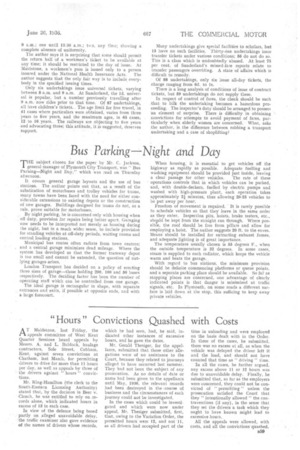Bus Parking Night and Day
Page 101

If you've noticed an error in this article please click here to report it so we can fix it.
THE subject chosen for the paper by Mr. C, Jackson, general manager of Plymouth City Transport, was " Bus Parking—Night and Day," which was read on Thursday afternoon.
It covers general garage layouts and the use of bus stations. The author points out that, as a result of the substitution of motorbuses and trolley vehicles for trams, many towns have been faced with the need for either considerable extensions to existing depots or the construction of new garages. Buildings designed for trams do not, as a rule, prove suitable for motorbuses.
, By night parking, he is concerned only with housing when off duty, provision for repairs being better apart. Garaging now needs to be interpreted not merely as housing during the night, but in a much wider sense, to include provision for standing vehicles at off-duty periods, waiting rooms and central loading stations.
Municipal bus routes often radiate from town centres; , and a central garage minimizes dead mileage. Where the system has developed so that the former tramway depot is too small and cannot be extended, the question of outlying garages arises.
London Transport has decided on a policy of erecting three sizes of garage—those holding 200, 100 and 50 buses respectively. The deciding factor has been the number of operating staff which can be controlled from one garage:
The ideal garage is rectangular in shape, with separate entrances and exits, if possible at opposite ends, and with a large forecourt. When housing, it is essential to get vehicles off the highway as rapidly as possible. Adequate fuelling and washing equipment should be provided just inside, leaving a clear passage for other vehicles. The rate of these operations controls that in which vehicles can be parked, and, with double-deckers, fuelled by electric pumps and washed with high-pressure plant, each operation takes approximately 24 minutes, thus allowing 20-25 vehicles to be put away per hour, Freedom of movement is required. It is rarely possible to schedule vehicles so that they leave in the same order as they enter. Inspection pits, hoists, brake testers, etc., should be kept from the straight run through. Where possibre, the roof should be free from pillars and allow for employing a hoist. The author suggests 20 ft. to the eaves. Means should be installed for extracting exhaust fumes, and adequate lighting is of great importance.
The temperature usually chosen is 55 degree's F., when the outside temperature is 32 degrees. In some cases, steam is supplied to each radiator, which keeps the vehicle warm and heats the garage.
With regard to bus stations, the minimum provision should be definite commencing platforms or queue points, and a separate parking place should be available. So faras stopping places are concerned, one advantage of clearly, indicated points is that danger is minimized at traffic signals, etc. In Plymouth, on some roads a different surface is laid down at the stop, this sufficing to keep away private vehicles.












































































































































